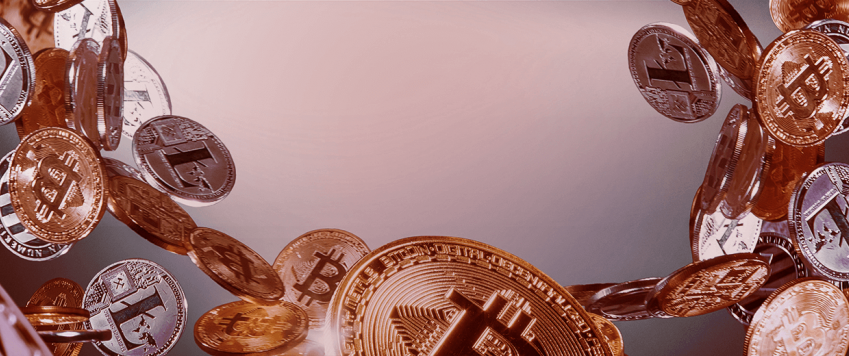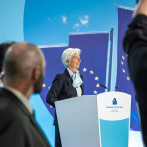Crypto-assets in Latvia: first steps in evaluation

Payment card statistics and keyword analysis of web browsers suggest that interest of Latvia's population in crypto-assets is low for the time being, but with an increasing trend.
Īsumā
-
Overall, Latvia's population shows relatively little interest in crypto-assets, it flickers occasionally and in certain regions.
-
In the first three quarters of 2021, card payments to top up crypto wallets reached 38.8 million euro (almost equal to gambling payments).
-
Accounts opened with Lithuanian and Maltese payment institutions dominate in card payments made to crypto wallet firms;
-
Investments in crypto-assets made by Latvia's population is highly dependent on the bitcoin price, even overdependent.
So far, the amount of one transaction made with a payment card to top up a crypto wallet has also been relatively small – almost half of the transactions (43%) do not exceed 60 euro. My study shows that investments by Latvia's population in crypto-assets is greatly influenced by the bitcoin price (BTC/euro).
This is not surprising, but it makes you think: crypto-assets, especially bitcoin, are speculative assets, not a regulated digital currency. I just want to say that those who are responsible for increasing financial literacy should also pay special attention to the small amateur investor in the future. For example:
- by making a private investor familiar with a method by which he/she can determine the fair value of an asset;
- by helping one to understand his/her "loss bearing tolerance" when speculating, and
- how to develop an investment strategy for an individual investor (i.e. when to buy and when to sell any asset; choose and hold on to the investment period; and stick with the good old saying: "do not put all eggs in one basket" or, in other words, the role of diversification in building an investment portfolio should be borne in mind;
- how to measure and manage the risk of speculation in the portfolio.
In order to analyse the prevalence of crypto-assets in Latvia, we will examine the data on payments made with cards issued by Latvian banks to top up crypto wallets and, for the first approximation, we will look at Google Trends analytical data on keywords searched by Latvia's residents related to the crypto-asset ecosystem.
Data on the keywords searched by Latvia's population using the Google search engine [1] show that in general interest of Latvia's population in crypto-assets is limited. The number of searches rises only when relevant information about the crypto-asset world appears on social media (for example, announcements about bitcoin by Elon Musk from the electric car giant Tesla or news about the crypto-asset dogecoin) (see Chart 1). Searches were more frequent in 2021, and general interest in the word "crypto" is growing.
Chart 1. The relative popularity of crypto-assets searched using Google by keyword
*(i.e. popularity among these five keywords) and the dynamics of searches over a certain period of time (from 1 January 2020 to 5 October 2021) in relation to the maximum number of searches in this period
Source: Google Trends [2]
Note: The more often a word is searched, the darker the region.
From a geographical perspective, data on crypto interest in Latvia show that information about bitcoin compared to other crypto-assets has been sought in a larger part of Latvia. In addition, the intensity of interest in bitcoin in some municipalities of Kurzeme and Vidzeme even exceeds that observed in the more densely populated Pieriga region and Riga. Dogecoin and crypto searches are very similar, and they are concentrated in a few cities, mainly in Riga and Pieriga region. Ethereum, on the other hand, is of least interest to the population, although in reality it has a great potential for application (ethereum is a DLT technology that is one of the most suitable for decentralised financial networking and product development (smart contract), unlike bitcoin-based DLT).
New data source – payment card data
Newly obtained data for the period since the beginning of 2020 allow for quantifying investments in crypto-assets (payments to virtual wallet holders [3]) made with payment cards issued in Latvia. Namely, the regulation of Latvijas Banka that entered into force in August 2021 determines, among other things, the range of credit institutions that must provide detailed weekly data on card payments (specifically, if the share of card payments exceeds 5% of the total number of card payments in the country).
In the first nine months of 2021, payments of Latvia's residents [4] to crypto-asset wallet holders reached 38.8 million euro, ranking 19th [5] in the total group of card payments. This is close to the amount of card payments for gambling but lags far behind card payments for basic needs.
Data on payments to top up crypto-asset wallets show an exponential growth until May 2021, when the total amount of payments made per month reached seven million euro. This growth trend was in line with the increase in crypto-asset market capitalisation in the world. The upward trend stopped after Elon Musk's announcements that bitcoin mining consumes too much electricity and therefore the use of this crypto-asset is unsustainable, and Tesla is discontinuing accepting this crypto-asset as a means of payment. At the same time, the dogecoin bubble burst when it turned out that dogecoin was created as a joke and had no intrinsic value. The crypto-asset market is fragile and trust-based, not to mention the high risk of being cheated or indirectly involved in money laundering if you have bought crypto-assets from a criminal or sold them to a person with criminal background.
Chart 2 Payments for gambling and topping up crypto-asset wallets made with payment cards issued by Latvian credit institutions per month (millions of euro) Sources: Latvijas Banka, author's calculations.
Chart 3 shows the dominance of small-scale payments, i.e. 43% and 96% of the payments made do not exceed 60 euro and 1000 euro respectively.
Chart 3. Distribution of the average daily amount of payments made with payment cards issued by Latvian credit institutions to top up crypto-asset wallets (extreme values excluded), January 2021–September 2021 (number) Sources: Latvijas Banka, author's calculations.
As regards the payments made, European countries (Lithuania, Malta, Czechia) dominate in the breakdown by country. The above countries enjoy a developed ecosystem of new financial technology FinTech (and crypto) as well as often have an insufficiently strict framework for preventing the risks of terrorist financing and money laundering. Payments to Lithuania increased significantly in 2021 but decreased to the United Kingdom (UK) due to the fact that Lithuanian payment institutions serve non-financial corporations providing crypto-asset services.
The significant drop in payments to UK payment institutions in June 2021 could be explained by the fact that in June 2021 the British supervisor ordered one of the world's largest crypto exchanges, Binance, to cease its activities in the UK , and a large number of crypto-asset firms suspended their UK licensing process. Part of the payment flows were taken over by Czech, Estonian and Irish payment institutions (their share in total payments grew the fastest).
Payments to Estonia accounted for a relatively small share (7.8%) between January 2020 and September 2021 (payments made to Latvian payment institutions – only 2.2%).
Chart 4. Payments made with payment cards issued by Latvian credit institutions by country of the crypto-asset wallet maintainer's account, January 2020–September 2021 (millions of euro)
Sources: Latvijas Banka, author's calculations
At the same time, it cannot be ruled out that the amount of investments made is higher, as data are not provided by all credit institutions. Customers of these credit institutions may not be active payment card users and may invest in crypto-assets. The analysis also excludes investment made using payment cards issued in other countries, such as Revolut.
Are decisions by Latvia's investors excessively influenced by the bitcoin price?
Looking at investments made by Latvia's population in crypto-assets, it seems that they were quite related to the bitcoin price (see Chart 5). The fact that crowd behaviour is widespread in crypto-asset markets has already been noted in academic sources. Moreover, investors' exaggerated behaviour in crypto-asset markets is more pronounced than, for example, in the S&P 500 index. What are the reasons for this? They are: financial (il)literacy and risk aversion as well as "dependence" on the good or bad news[6] . Investors who are over-optimistic are younger, their levels of education and incomes are lower. Investing in alternative assets has also become widely available to non-professional investors. Therefore, it is important to increase financial literacy of each non-professional investor in order to avoid significant losses. That is why Latvijas Banka, together with the Financial and Capital Market Commission, has identified the improvement of financial literacy as a priority.
Chart 5. Investments by Latvia's population in crypto-assets and the bitcoin price, January 2020–September 2021 Sources: European Central Bank, Yahoo Finance, Latvijas Banka, author's calculations.
So, the question was whether the bitcoin price affects the behaviour of Latvia's investors. My short answer is yes. It is based on the results of the modelling method, which is explained in more detail below, but please note that it is a "hardcore" with the #GEEKSTUFF.
Methodology
Data: Payments to crypto-asset companies made with cards issued by Latvian commercial banks, thousands of euro, weekly amount and BTC/euro average weekly price for the period from 1 January 2020 to 17 October 2021.
Model: ARDL (autoregressive distributed lag model) and ECM (error correction model). The model allows for separating the short-term and long-term connection between different indicators, while allowing the dependence of the indicators on the delayed values.
Model results: The dependence of investment changes on the BTC/euro price in the short and long term has been proven. In addition, strong positive coefficients at BTC (–1) show that the choice of Latvia's population to top up their crypto-asset wallets is very strongly dependent on the BTC price (in 2021, with the BTC price increasing/decreasing by 1 euro, the change in investments accelerated by 29.32 thousand euro). The results show that in the long run the BTC price affects investments of Latvia's population to a greater extent than in the short term, moreover, the relationship was stronger in 2021.
The results pass the robustness checks.
|
|
2020–2021 |
2020 |
2021 |
|
|
Short-term relationship (ARDL/CECR) |
||||
|
D (investment, thous. euro) |
||||
|
C |
20.11 (0.44) |
30.51 (0.2093) |
34.31 (0.8546) |
|
|
Investment(–1)* |
0.52 (0.0000) |
0.47 (0.0002) |
0.51 (0.0000) |
|
|
BTC (-1) |
13.95 (0.0000) |
15.04 (0.0026) |
||
|
D(BTC) |
18.34 (0.0022) |
19.94 (0.0475) |
||
|
BTC |
10.56 (0.0016) |
|||
|
Long-term relations (level equation) |
||||
|
BTC |
26.75 (0.0000) |
22.50 (0.0000) |
29.32 (0.0043) |
|
|
C |
38.57 (0.2354) |
64.98 (0.1807) |
66.89 (0.8568) |
|
|
F-bounds test (No levels relationship) F-statistic, I(0), I(1) |
20.005 (3.02-3.51) |
5.92 (3.02-3.51) |
8.61 (3.02-3.51) |
|
|
Robustness |
||||
|
Breusch-Godfrey serial correlation LM test (Chi-square (5)) |
0.9050 |
0.1257 |
0.2331 |
|
|
Breusch-Pagan-Godfrey homoscedasticity test Prob. Chi-Square (3) |
0.0000 |
0.5383 |
0.3568 |
|
|
HAC standard error & covariance |
Barlett kernel, Newey-West fixed bandwidth= 4.000 |
n/a |
n/a |
|
|
Observations |
93 |
52 |
41 |
|
|
Max lags |
4 |
4 |
4 |
|
|
The most appropriate model selection method |
Schwartz criteria |
Schwartz criteria |
Schwartz criteria |
|
|
Number of evaluated models: |
20 |
20 |
20 |
|
|
Selected model: |
ARDL (1,1) |
ARDL (1,0) |
ARDL (1,1) |
|
[1] The numbers show the search intensity in one week in Latvia from the beginning of 2020 to the beginning of October 2021 in relation to the highest point of the chart, i.e. 100 points mean the highest popularity of keywords in the selected period between these five words (the keyword "bitcoin" in the second week of May 2021). 50 points mean half the popularity of the keyword, while 0 means that the keyword was used rarely or not at all). Compared to the word "Covid", the popularity of these five words is low.
[2] Exploration of crypto, bitcoin, dogecoin, ethereum, diem using Google Trends includes only queries made from Latvian IP addresses. Searches made from a VPN (virtual private network that allows encrypted internet access and encrypts internet activity) are not covered.
[3] Merchant code 6051 includes payments in foreign currency made by non-financial institutions, money transfers and travellers' checks. MasterCard and Visa have specified that this code should also include crypto-assets and payments to crypto wallet maintainers. It is assumed that payments classified under code 6051 can be recognised as payments to top up crypto-asset wallets.
[4] The available data do not make it possible to distinguish between payments made by individuals and those made by companies, but these types of payments to holders of crypto-asset wallets are payments specific to individuals.
[5] Author's calculations using payment card data.
[6] Tabassum et.al., 2021. Behavioral factors affecting investment decision-making. Behavior in a moderating role of financial literacy: a case study of local investors of Pakistan stock market. International Journal of Management, Vol. 12, Iss. 2, 2021, pp.321-354, DOI: 10.34218/IJM.12.2.2021.035
Vēlos informēt, ka tekstā:
«… …»
Jūsu interneta pārlūkā saglabāsies tā pati lapa






